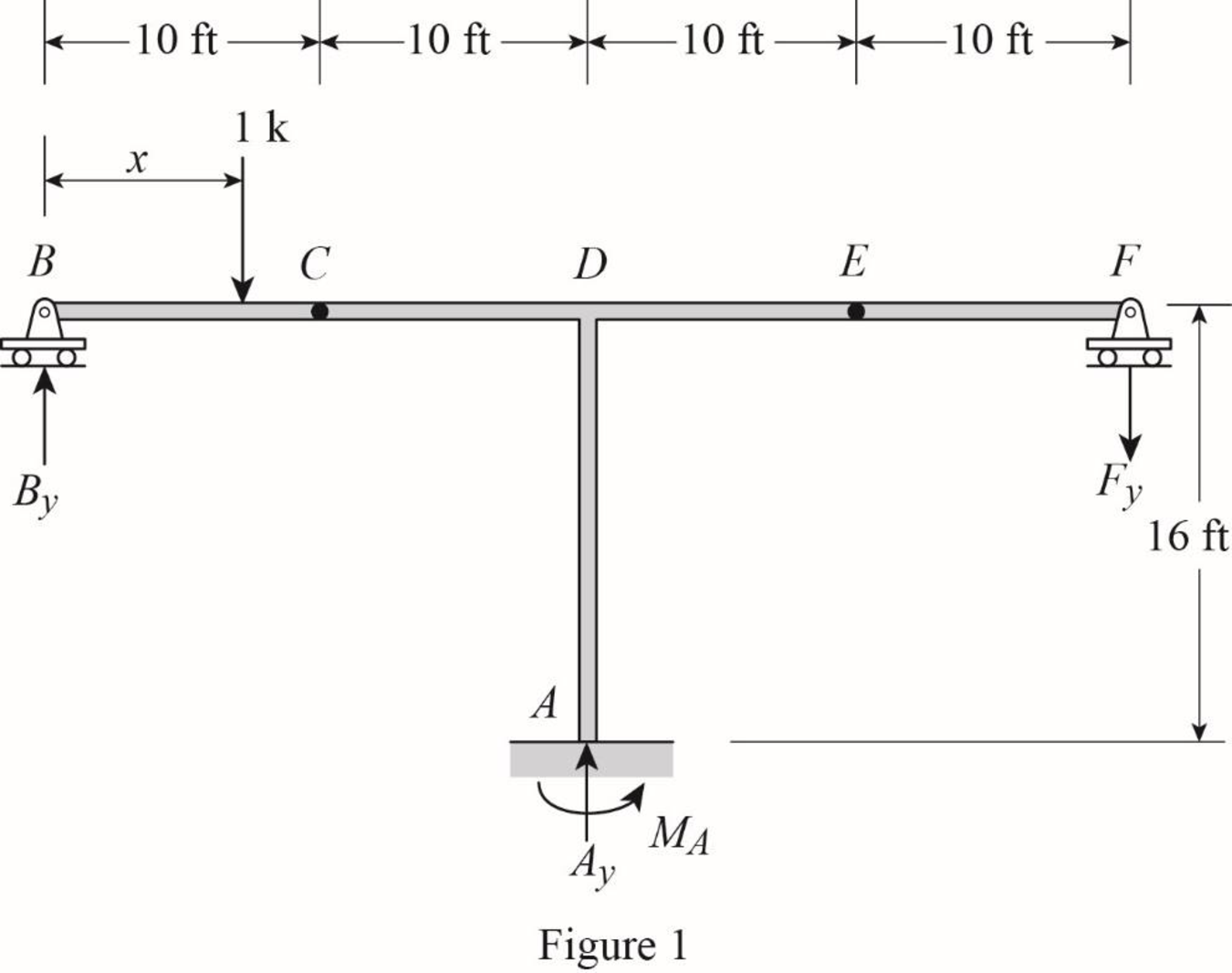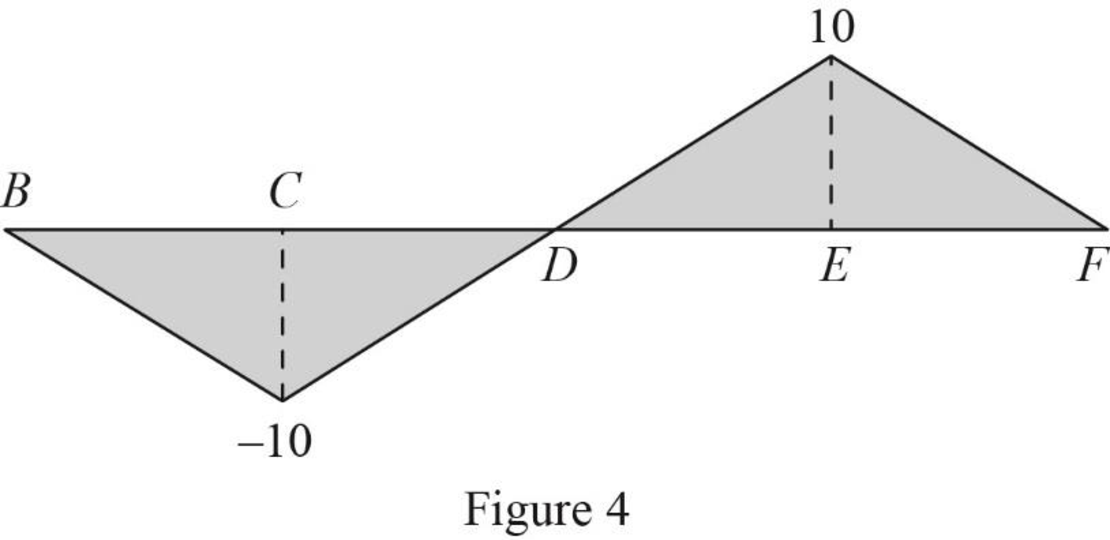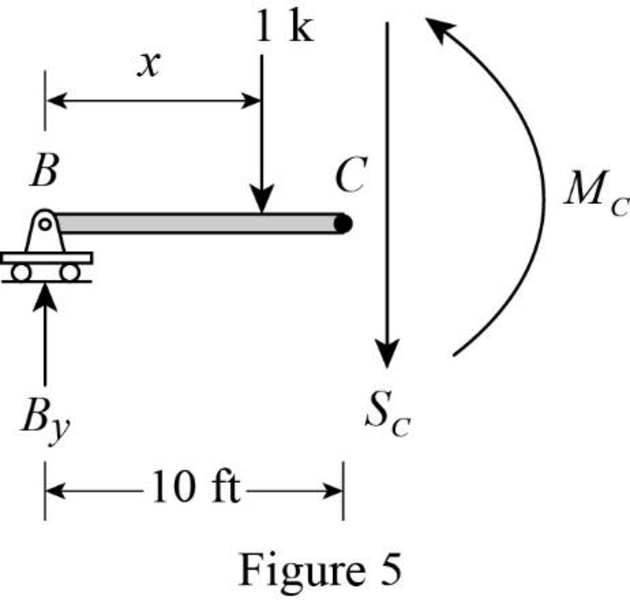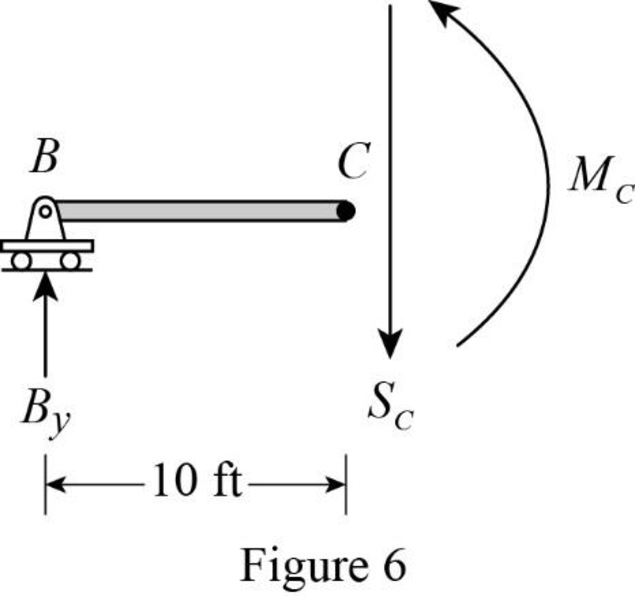
Concept explainers
Draw the influence lines for the reaction moment at support A, the vertical reactions at supports A and B and the shear at the internal hinge C.
Explanation of Solution
Calculation:
Influence line for vertical reaction at support B.
Apply a 1 k unit moving load at a distance of x from left end B.
Sketch the free body diagram of frame as shown in Figure 1.

Refer Figure 1.
Apply 1 k load just left of C
Consider section BC.
Consider moment equilibrium at C.
Take moment at C from B.
Consider clockwise moment as positive and anticlockwise moment as negative.
Apply 1 k load just right of C
Consider section BC.
Consider moment equilibrium at C.
Take moment at C from B.
Consider clockwise moment as positive and anticlockwise moment as negative.
Thus, the equation of vertical support reaction at B as follows,
Find the influence line ordinate of
Substitute 0 for
Thus, the influence line ordinate of
Similarly calculate the influence line ordinate of
| x (ft) | Points | Influence line ordinate of |
| 0 | B | 1 |
| 10 | C | 0 |
| 20 | D | 0 |
| 30 | E | 0 |
| 40 | F | 0 |
Sketch the influence line diagram for vertical support reaction at B using Table 1 as shown in Figure 2.

Influence line for vertical reaction at support A.
Apply a 1 k unit moving load at a distance of x from left end C.
Refer Figure 1.
Find the vertical support reaction
Apply 1 k load just left of E
Consider section EF.
Consider moment equilibrium at point E.
Consider clockwise moment as positive and anticlockwise moment as negative
Apply 1 k load just right of E
Consider section EF.
Consider moment equilibrium at point E.
Consider clockwise moment as positive and anticlockwise moment as negative
Thus, the equation of vertical support reaction at F as follows,
Apply a 1 k unit moving load at a distance of x from left end B.
Refer Figure 1.
Apply vertical equilibrium in the system.
Consider upward force as positive and downward force as negative.
Find the equation of vertical support reaction
Substitute
Find the equation of vertical support reaction
Substitute
Find the equation of vertical support reaction
Substitute
Thus, the equation of vertical support reaction at A as follows,
Find the influence line ordinate of
Substitute 40 ft for
Thus, the influence line ordinate of
Similarly calculate the influence line ordinate of
| x (ft) | Points | Influence line ordinate of |
| 0 | B | 0 |
| 10 | C | 1 |
| 20 | D | 1 |
| 30 | E | 1 |
| 40 | F | 0 |
Sketch the influence line diagram for the vertical reaction at support A using Table 3 as shown in Figure 3.

Influence line for moment at support A.
Apply a 1 k unit moving load at a distance of x from left end B.
Refer Figure 1.
Apply 1 k load just left of C
Take moment at A from B.
Consider clockwise moment as positive and anticlockwise moment as negative.
Substitute
Apply 1 k load just right of C to just left of D
Take moment at A from B.
Consider clockwise moment as positive and anticlockwise moment as negative.
Substitute
Apply 1 k load just right of D to just left of E
Take moment at A from F.
Consider clockwise moment as positive and anticlockwise moment as negative.
Substitute
Apply 1 k load just right of E
Take moment at A from F.
Consider clockwise moment as positive and anticlockwise moment as negative.
Substitute
Thus, the equation of moment at A as follows,
Find the influence line ordinate of
Substitute 0 for
Thus, the influence line ordinate of
Similarly calculate the influence line ordinate of
| x (ft) | Points | Influence line ordinate of |
| 0 | B | 0 |
| 10 | C | ‑10 |
| 20 | D | 0 |
| 30 | E | 10 |
| 40 | F | 0 |
Sketch the influence line diagram for the moment at support A using Table 3 as shown in Figure 4.

Influence line for shear at point C.
Find the equation of shear force at C of portion BC
Sketch the free body diagram of the section BC when 1 k load placed between BC as shown in Figure 5.

Refer Figure 5.
Apply equilibrium equation of forces.
Consider upward force as positive
Substitute
Find the equation of shear force at C of portion CF
Sketch the free body diagram of the section BC when 1 k load placed between CF as shown in Figure 6.

Refer Figure 5.
Apply equilibrium equation of forces.
Consider upward force as positive
Substitute
Thus, the equations of the influence line for
Find the influence line ordinate of
Substitute 10 m for
Thus, the influence line ordinate of
Find the shear force of
| x (ft) | Points | Influence line ordinate of |
| 0 | B | 0 |
| 10 | ‑1 | |
| 20 | 0 | |
| 30 | E | 0 |
| 40 | F | 0 |
Draw the influence lines for the shear force at point C using Table 4 as shown in Figure 7.

Therefore, the influence lines for the moment at support A and the vertical reactions at supports A and B and the influence lines for the shear hinge C are drawn.
Want to see more full solutions like this?
Chapter 8 Solutions
Structural Analysis, SI Edition
- Thank you for your help if you would also provide the equations used .arrow_forwardThe sectors are divided as follows:top right = 1, top left = 2, middle = 3, bottom = 4.(a) Determine the distance yˉ to the centroid of the beam’s cross-sectional area.Solve the next questions by building a table. (Table format Answers) (b) Determine the second moment of area (moment of inertia) about the x′ axis. (c) Determine the second moment of area (moment of inertia) about the y-axis.arrow_forwardinstructions: make sure to follow the instructions and provide complete and detailed solution create/draw a beam with uniformly distributed load and concentrated load after, find the shear and moment equation and ensure to draw it's shear and moment diagram once done, write it's conclusion or observation 4:57 PMarrow_forward
- Solve for forces on pin C and Darrow_forwardBorrow pit soil is being used to fill an 900,00 yd3 of depression. The properties of borrowpit and in-place fill soils obtained from laboratory test results are as follows:• Borrow pit soil: bulk density 105 pcf, moisture content = 8%, and specific gravity = 2.65• In-place fill soil: dry unit weight =120 pcf, and moisture content = 16%(a) How many yd3 of borrow soil is required?(b) What water mass is needed to achieve 16% moisture in the fill soil?(c) What is the in-place density after a long rain?arrow_forwardsolve for dt/dx=f(t,x)=x+t^2arrow_forward
- Calculate the BMs (bending moments) at all the joints of the beam shown in Fig.1 using the slope deflection method, draw the resulting shear force diagran and bending moment diagram. The beam is subjected to an UDL of w=65m. L=4.5m, L1= 1.8m. Assume the support at C is pinned, and A and B are roller supports. E = 200 GPa, I = 250x106 mm4.arrow_forwardProblem 2 (A is fixed and C is a pin) Find the reactions and A and C. 10 k- 6 ft 6 ft B A 2 k/ft 15 ftarrow_forward6. A lake with no outlet is fed by a river with a constant flow of 1200 ft3/s. Water evaporates from the surface at a constant rate of 13 ft3/s per square mile of surface area. The surface area varies with the depth h (in feet) as A (square miles) = 4.5 + 5.5h. What is the equilibrium depth of the lake? Below what river discharge (volume flow rate) will the lake dry up?arrow_forward
- Problem 5 (A, B, C and D are fixed). Find the reactions at A and D 8 k B 15 ft A -20 ft C 10 ft Darrow_forwardProblem 4 (A, B, E, D and F are all pin connected and C is fixed) Find the reactions at A, D and F 8 m B 6m E 12 kN D F 4 marrow_forwardProblem 1 (A, C and D are pins) Find the reactions and A, C and D. D 6 m B 12 kN/m 8 m A C 6 marrow_forward
